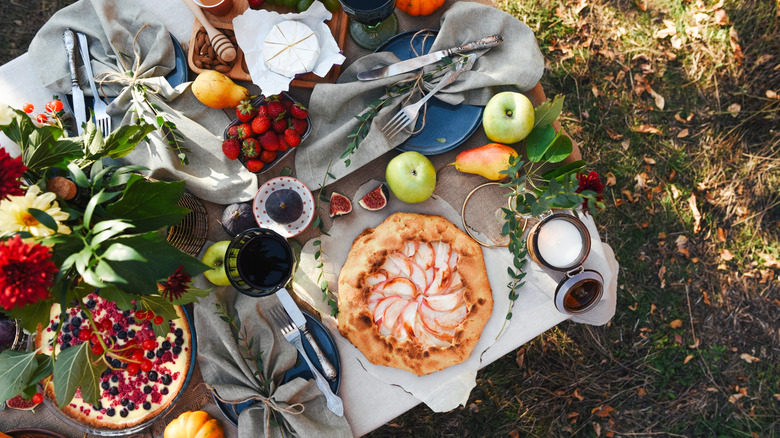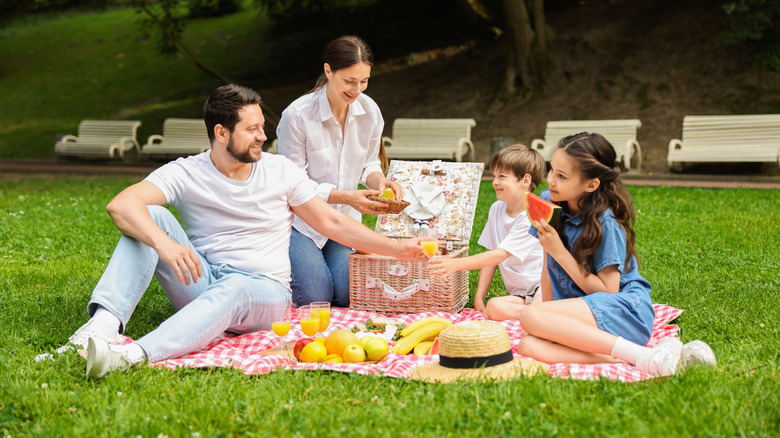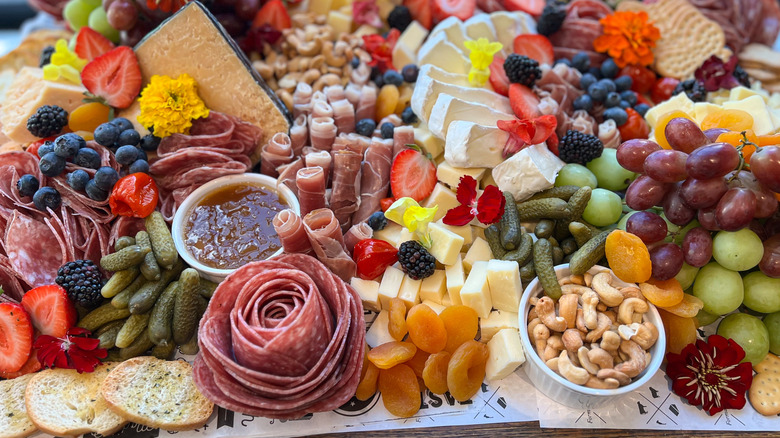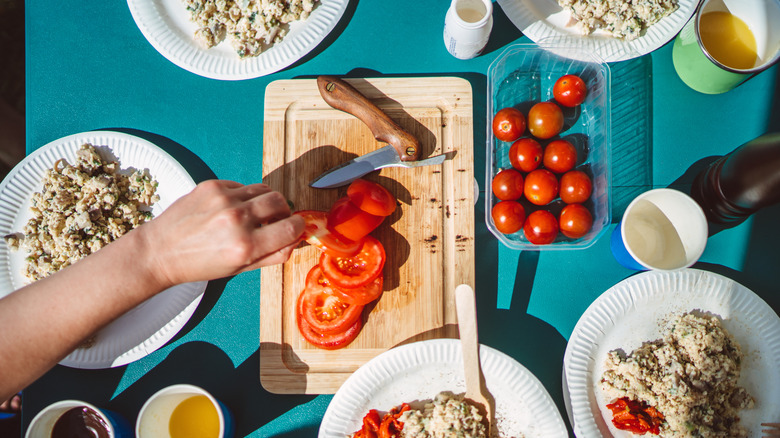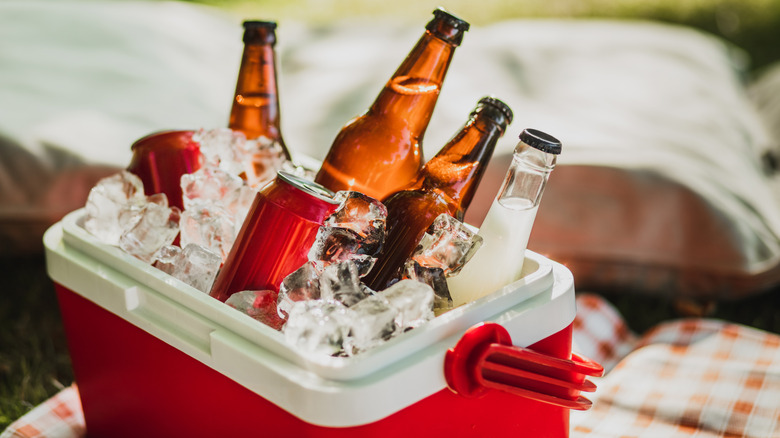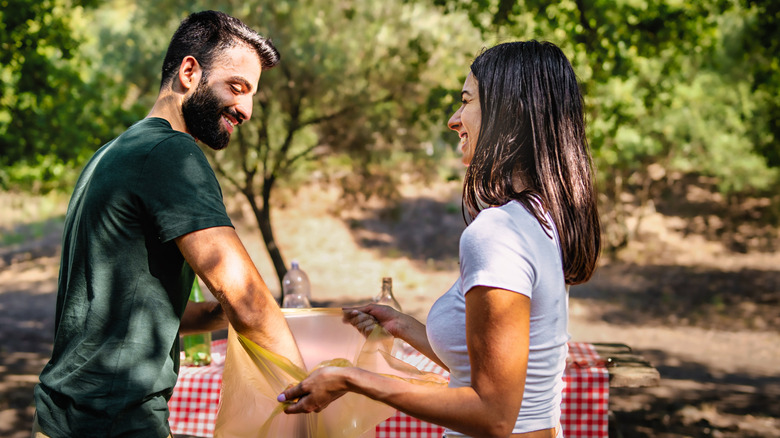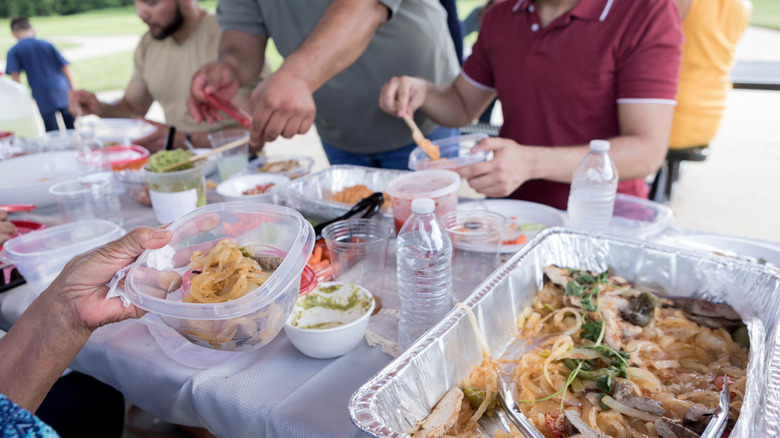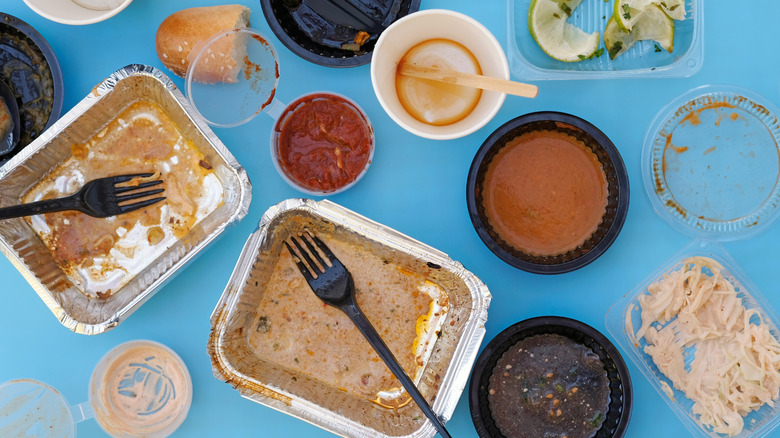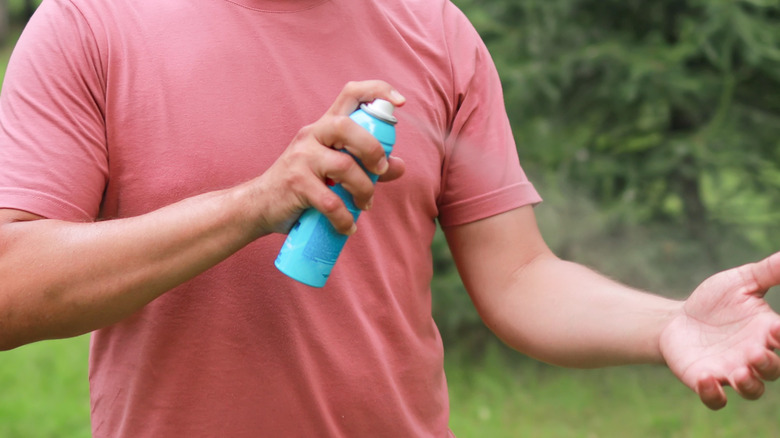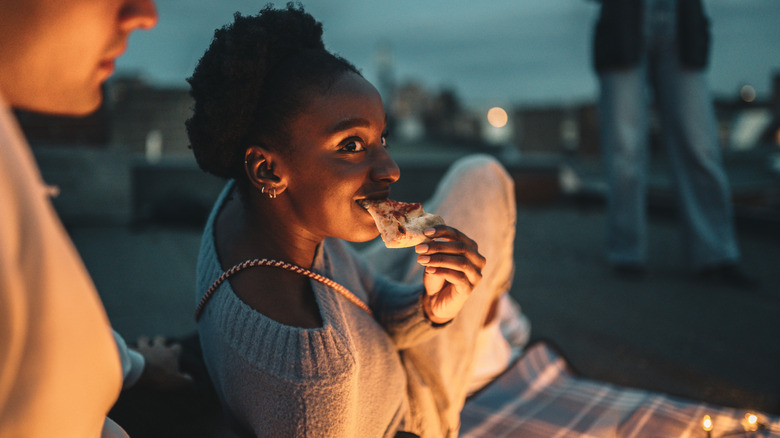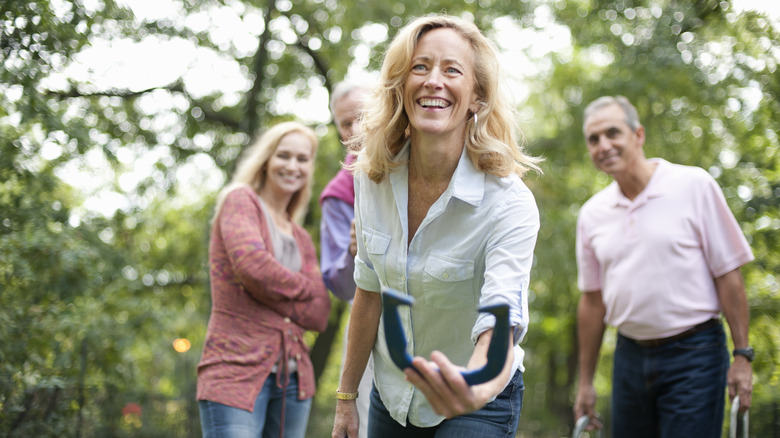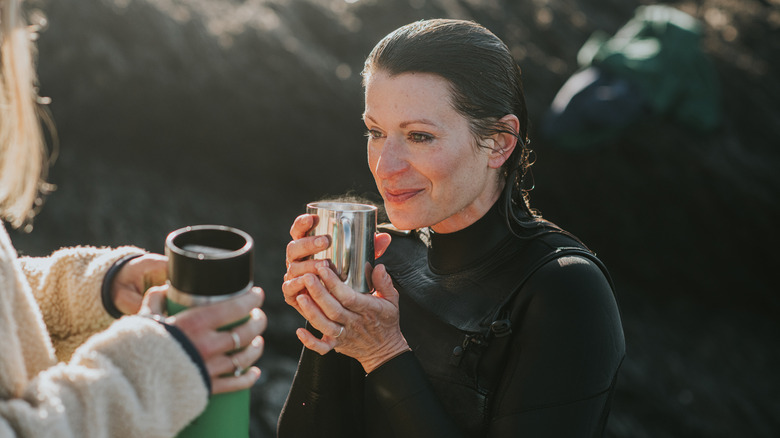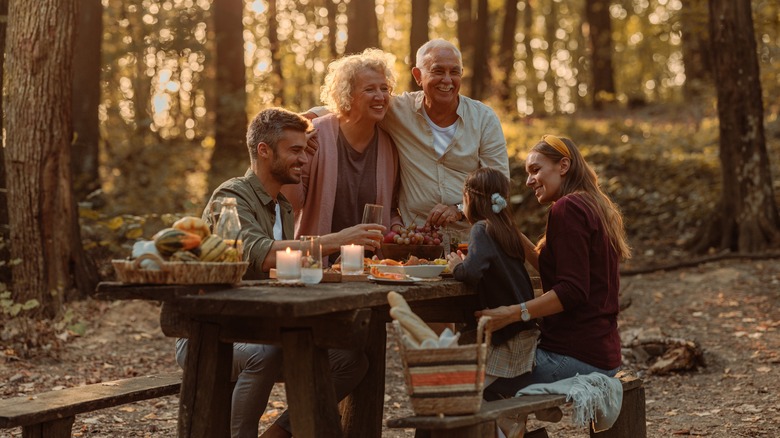12 Mistakes You're Making When Planning An Outdoor Picnic
Starting in the early part of spring, the people who have felt perpetually stuck at home long to shake off the shackles of cabin fever and run barefoot and unfettered over hill and dale. Ideally, it'll be a jaunt that inspires a huge appetite, one that's satiated by a basket of abundant fresh seasonal fruits and vegetables, gourmet sandwiches served on sweet brown bread, and a little wine or homemade lemonade to wash it down. All of this would, of course, be consumed on the banks of some creek situated on the outskirts of Small Town, Anywhere, with cool breezes coming off the water, flavoring the meal just so. If your picnics don't include a scene like the one described above — or at least, the spirit of it — you might be unknowingly committing the first of possibly many picnic mistakes.
But you don't have to accept this and other picnic faux pas as inevitable. If you arm yourself with a list of all the mistakes you might possibly make before you pack up the proverbial picnic tote, you'll spend more time with toes in the water, downing your favorite sammies, and less time swatting away the flies that threaten the felicity of your outdoor meal. To that end, we look at 12 of the most common mistakes people make when they get their picnic on. We also offer some outdoor cooking hacks to put yourself back on the Trail of Bliss and the perfect picnic.
1. Choosing the wrong spot
If a restaurant's ambiance did not play such a critical role in our perceived enjoyment of the dining experience, the eatery in question would not bother with restaurant design at all. However, the dining atmosphere is very important, and truth be told, a nice atmosphere doesn't just make a difference when we dine at our favorite establishment. It matters when we set out for a picnic, too. Some of this is purely a matter of aesthetics. Food just seems to go down easier when we're surrounded by lush green trees, soft grasses, and perhaps the scent of fresh water coming off a lake or river. Being surrounded by all those blues and greens promotes serenity.
However, the comfort of a picnic site, and not just its aesthetics, also play a big role. Something as simple as being able to sit under a shade tree on a hot day makes a huge difference. If you're hot and nearly succumbing to heat stroke, you're not going to enjoy your time outdoors. Even little details, like whether or not there is a water spigot nearby or clean public restrooms, dictate having the opportunity to freshen up after dinner or not. Finally, if you've been hankering for some grilled hot dogs, having access to built-in barbecue pits means you get to include your favorite food at your picnic (or not).
2. Bringing complicated food
It can be tempting to bring something that's not only really delish but also elaborate to your next picnic. However, the reality is that complicated food makes things, well, complicated, and picnics, ideally, are simple. They're supposed to be all about spontaneous frisbee-play with people you just met, a bike ride down a long stretch of the city's greenbelt, and general bouts of laziness. So, unless you're planning on grilling a steak or some hot dogs, your picnic calls for easy peasy food.
But that doesn't mean it's less yummy. Think ready-made, though no less gourmet, sandwiches, or skip the bacon, lettuce and tomato sammies and go with BLT pasta salad instead. If you're a cold cuts kind of foodie, few things get easier than charcuterie, with its slices of spicy salami or ham, cubes of nutty cheese, sliced fruit, and an assortment of crackers and bread. If you're more of a picnic purist, then pack along homemade fried chicken, steamed pieces of corn on the cob, and a serving or two of mac and cheese. To complete the meal, wrap up some dinner rolls and some compound butter to flavor them with. In short, if it's not simple and easy to carry along, save it for another day.
3. Not bringing disposables
Ceramic plates and tall Champagne flutes are the stuff of old-fashioned movies. In those old flicks, the only thing that's more certain than the two co-stars falling in love is the promise that the picnic will end with a rain storm. Fast forward to the modern, non-movie world: Reality dictates that dish-breakage and the lack of copious amounts of rain are the things that threaten to put an end to a picnic. This is one of the chief arguments for carrying along paper plates, plastic drink cups (including for wine and beer), and disposable utensils. There's no worry about anything breaking.
With the exception of possibly a steak that you grill, which would require a steak knife, most of your food will eat just the same, regardless of what kind of dinnerware you have. However, if you happen to feel nostalgic about using "real" plates and utensils on a picnic, then you may want to buy an insulated picnic backpack or basket with plastic plates and drinkware. These features prevent breakage while still allowing you to have more permanent fixtures. The other kind of disposables you'll want to bring along are packets of salt and pepper, along with picnic-sized containers of mayo, mustard, ketchup, and other condiments. Unless you're serving a large group, you won't need full jars of sauces. You might as well save the space in your picnic basket for more food.
4. Using only one cooler
Packing a cooler is a bit like playing Tetris with your food. Align everything in just the right way and next to the appropriate items, and you'll have a cornucopia of delights that are easy to move and ready to be devoured. Pack it the wrong way, and you end up with icy water in your wrapped deli sandwiches and mayo on the mouth of your cans of Cola. However, if you pack two coolers instead of one, soggy lunch can be a thing of the past.
You'll pack each cooler with some specific items. Thirsty picnickers dig into the cooler before, during, and after meals for drinks. This constant opening-and-closing of the lid is what causes the ice to melt, which is the reason why you should pack drinks in one cooler and your food in a second cooler. Put drinks by themselves in the first cooler. You won't be opening the second one as often, so the ice melts a lot more slowly. Make the second cooler the food cooler. You may want to skip the bagged ice for this one and use a couple of those reusable Igloo blue ice packs instead. When the ice in those melt, the water stays safely inside the bottle, away from your food.
5. Not packing a little extra
Most people avoid carrying extra food, drinks, plates, and utensils in their picnic baskets because they don't want it to be too heavy or they're afraid that the food will go bad. This is usually a wise decision. However, there are also times when the opposite can be the case. Forks get dropped in the dirt. Old friends unexpectedly ride their bikes by your picnic site and have brought their hunger with them. You worked up more of an appetite on your hike than you expected. In all of these cases, having an extra sandwich packed or a second, smaller Trader Joe's charcuterie board can't hurt.
However, if you're concerned about packing too much, you can narrow the scope of the extras you'll bring along. You may not need to pack two sandwiches for everyone. However, you should pack some extra — of at least some things, anyway. Extra garbage bags and ziptop bags are a must. They allow you to clean up the picnic site when it's time to go. Extra drinks — water, in particular — are required if the day is going to be particularly hot or you'll be doing a lot of strenuous activities. And speaking of hot, it's not a bad idea to pack extra hats and sunscreen while you're at it.
6. Forgetting about the leftovers
Provided that you're equipped to deal with them, a good stack of leftovers means lunch for another day, and with some pre-event planning, even your picnic goodies can be among that surplus. First of all, much of the food you'll pack along will probably already be in pack-and-carry plastic bowls with lids. Once you're finished with lunch, it's just a matter of snapping the lid back on the Tupperware and putting the container back into the cooler with plenty of ice on top of it. Second, you'll need to pack a variety of ziptop baggies of different sizes. The bigger freezer-bag size will hold big blocks of cheese, slices of bread and crackers, and the different meats you've assembled on your charcuterie board. Smaller ones are good for sandwiches.
If you reuse plastic utensils (or you've packed along the "real thing"), you'll want a separate bag for those as well. This prevents any food that sticks to the heads of the utensils from sliming the insides of your picnic basket or backpack until you can get home to wash them. Finally, a container of wet wipes cleans your hands quickly, while some Lysol multi-surface disinfecting wipes are just what you need to sanitize your picnic area, portable chairs, and any other items that have gotten dirty during lunch.
7. Taking food home that's been left out too long
All food has a danger zone, and if you've gotten involved in your after-picnic play, you may have left your food out in the open, risking putting those nummies in a bad situation. So what is the danger zone, and when does food go from being still good enough to eat to becoming a four-alarm fire? According to the USDA, when food sits in temperatures between 40 degrees Fahrenheit and 140 degrees Fahrenheit, the bacteria in it starts increasing. It doesn't even take long; give things just 20 minutes and the microscopic critter population becomes twice what it was just minutes before. The USDA says if the temps are below 90 degrees Fahrenheit, you have about a two-hour window to keep the food out. If it's over 90 degrees Fahrenheit, you have an hour. On the off-chance that you've inadvertently left food out longer than you're supposed to, don't risk getting yourself or your family members sick. It's better to toss the food out rather than take it home with you.
That said, if you really want to eat your picnic leftovers another time, be sure to pack them back in the cooler right after you're done eating — before you even break out the Toss Across game. If you feel like you need some after-dinner snacks, you can always pull the food back out. Or bring packaged snacks, like nuts, dried foods, and cookies to nibble on instead. These won't go bad and are good remedies for after-dinner peckishness.
8. Leaving bug repellent at home
When you picnic, you get fried chicken for lunch, and in turn, bugs get you for dinner. The reality is biting bugs like mosquitoes can make picnics perfectly miserable, so you should never plan an outdoor meal without also planning some strategies for dealing with bugs. At minimum, you can put on a BuggyBands mosquito-repellent bracelet. These all-natural bug bracelets are good options if you don't want to be lathered in a chemically-based bug spray. However, if you're in a mosquito-heavy area or are going to be out for a long time, particularly if you'll be celebrating into the evening hours when insects start biting, having a can of bug repellent with DEET might become necessary.
Other anti-bug options include burning citronella candles if they're permitted in the picnic area. You can also run fans, which mosquitoes have a hard time flying through. And because of this, it's harder to get at you. Finally, there is one overarching principle to keep in mind. Mosquitoes live and breed in and near water. If you're picnicking by a lake, you're more likely to experience biting bugs than if you're not sitting close go a body of water. So people that are going to enjoy their lunch lakeside should plan their trip and pest control accordingly.
9. Not planning for nightfall
It's probably safe to say that most people plan picnics for the daylight hours. However, that doesn't mean that the festivities will end once the sun starts to dip below the horizon. They'll keep on keepin' on and so will you, provided that you've planned for the drop in light and temperature. The list of must-haves you'll need to navigate going from double, possibly triple-digit weather to much cooler double-digit temperatures include clothing items, blankets, and lighting solutions. First up come items like sweatshirts and sweaters or a light jacket. These give you freedom of movement while still keeping the chill away. You may also find it helpful to bring a pair of jeans or even sweatpants that you can change into once it gets too brisk for shorts. A small blanket or shawl might also be in order if you think it'll get really cold. This could be the case if you're picnicking near water.
Finally, Etekcity Store LED tabletop lanterns bring some much-needed light to a picnic table of people chatting over a cup of after-dinner coffee. These lights can be battery-operated. Or if those don't suit your fancy, try solar lamps that come equipped with stakes, which you can push into the ground to keep stable. And you'll also need flashlights to light the way to the public restrooms and to give late-afternoon hikers the confidence they need to return to the picnic site in safety and comfort.
10. Not bringing a variety of games
Being the passionate foodie you are, the first order of your picnic should be all the great food you're going to chow down on. However, eventually your tummy will be full, and after a short postprandial snooze, you'll be ready to play. Although after-dinner conversation is likely to take up a great deal of your time, you'll miss much of the fun a picnic has to offer if you didn't bring along any games to play. Games help to break the ice if you're picnicking in a group of people you don't know very well, like new office mates. They also put the kibosh on the classic kiddo lament: "I'm bored!"
Some picnic games seem obvious. Frisbee? Of course. Badminton or volleyball: There's usually plenty of space in the park for those. Flag football or horseshoes is also a go. Other physical activities might include hula hoops, lawn darts, Toss Across, softball, kite-flying, scavenger hunts, and water balloon fights. For those who love less physically-demanding games, a deck of cards is always a good, and more importantly, compact option to bring along. Lastly, board games like Monopoly or Trivial Pursuit brings spirited but non-athletic fun to the table.
11. Not carrying along hot after-dinner drinks
Food rituals ground us in tradition and make eating more fun and meaningful. These can be as elaborate as cooking Christmas dinner together as a family to drinking coffee or tea after meals. In the latter case, those post-meal cups of cozies warm up the heart and the conversation. Because they're so meaningful and because picnics also play a role in the development and participation of food rituals, it makes sense to include the makings for coffee, tea, and other after-dinner drinks in your picnic basket.
If you're on a day trip, the easiest way to facilitate this is to bring along Thermoses of premade coffee or brewed tea. Powdered creamer, sugar packets, and plastic spoons, plus some Styrofoam cups or enamel coffee cups, ensure that there's something hot to drink once the meal ends. If you're camping and are picnicking at a campsite that has a grill or a place to build a fire, then you can boil water for tea and instant coffee or ground coffee over an open fire. In this case, you'll need not only the equipment to make the drink with, like the percolator coffee pot, but you'll also need ingredients like the instant or ground coffee, pour-over coffee pouches, and tea bags.
12. Disregarding seating options
Where you'll sit when you're on a picnic often depends on where you've landed. That is, are you at a city park, by a creek, or at an overnight campground? Your seating arrangements also determine just how comfortable you are while you eat. Therefore, you do want to give some thought to your seating before you embark on your picnic. For example, if you're going to a city or state park, it's likely that picnic tables and benches will be available. However, these can be uncomfortable to sit on over a long period of time, so you may want to bring a few camp cushions with you to sit on.
On the other hand, if you're sitting on the ground, look for a picnic blanket. Some types of blankets feature a soft, cozy fabric side on top and a water-proof liner on the bottom. The blankets are thick enough to be comfortably sat on and are reinforced enough to keep you dry once the evening dew starts to form on the grass. Finally, if getting up off the ground is difficult for any members of your party, like your grandparents, pack along a few foldable camp chairs and a portable table. This gives the sitters not only a comfortable place to sit but also a table on which to rest a plate and coffee cup, as well as any books, phones, and other important carry-along items.
